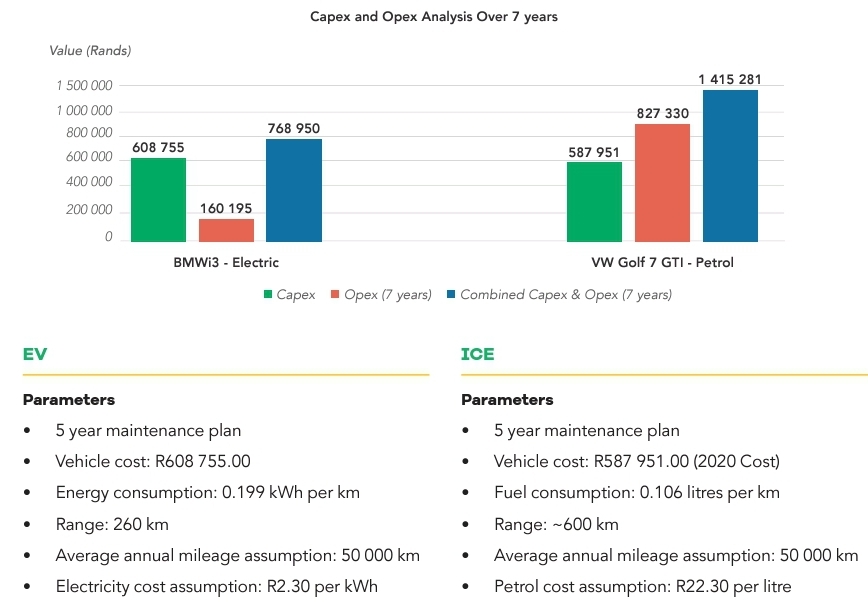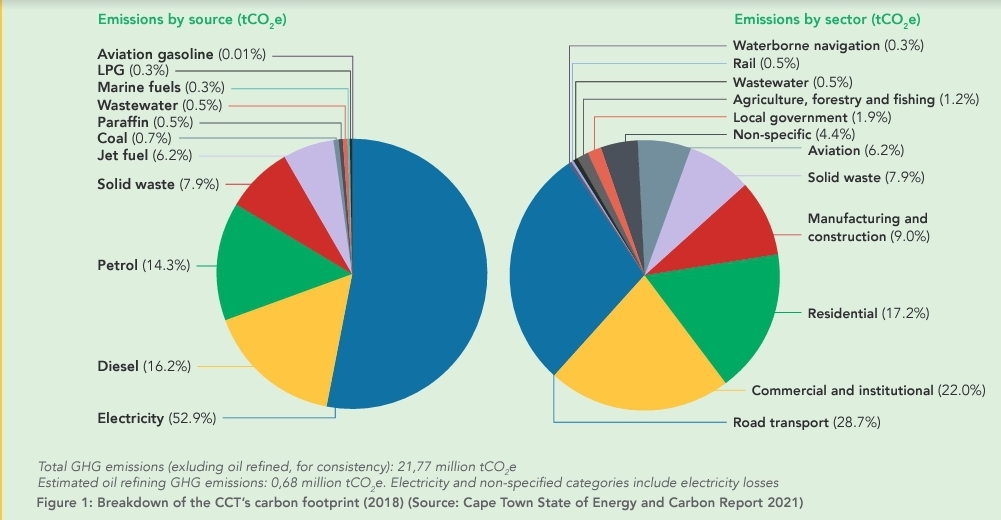Sign up for daily news updates from CleanTechnica on email. Or follow us on Google News!
Municipalities are known to operate large fleets to keep their operations going in several areas. A recent case study by the City of Cape Town’s transport department, in collaboration with GreenCape, gives some very valuable insights into some of these operations and how they can be electrified. The report cites that the City of Cape Town has a total fleet size of 9,386 vehicles across various departments. These departments include Corporate Services, MyCiti Bus Rapid Transit, Water and Sanitation, Urban Waste Management, and Energy.
One of the key insights we get from the report is that the City of Cape Town’s vehicle fleet had a total on-road fuel consumption of 15.9 million liters of diesel and 6.4 million liters of petrol between October 2021 and October 2022. This resulted in the City having a fuel bill of close to R465 million ($24.5 million) during that period. The report adds that the total annual CO2 emissions for the City’s vehicle fleet is 57,314 tonnes of CO2, based on the on-road fuel consumption data over the same period.
In line with the City’s Climate Change Action Plan (CCAP) goals of carbon neutrality by 2050 and the City’s drive to show leadership by gathering real-world data from the EV pilot program, the City procured five battery-electric vehicles (BEVs). The City also installed some charging stations as part of a pilot program to evaluate the case for electrifying its fleet. As part of the pilot program, the City highlighted that it was critical to get electric vehicles that are fit for purpose and that a suitable charging network is developed to support operational requirements for the specific use cases. One of the ideal operations for such a program was a fleet of 477 hatchbacks.
The GreenCape’s Report says:
“There are approximately 477 hatchback passenger vehicles in the CCT fleet which have the potential to be replaced with an electric alternative, based on the outcome of the CCT EV pilot project. Passenger vehicles have been identified as an opportunity for electrification due to the high annual mileage of this vehicle segment in the City’s fleet. The average annual mileage for a passenger vehicle (sedans and hatchbacks) in the CCT fleet is 35 000 km. The estimated annual fuel consumption of the 477 ICE hatchback vehicles is 1 769 670 litres of petrol with an estimated annual emissions amounting to 4 000 tonnes of CO2. The annual cost of refuelling all of the ICE hatchback vehicles in the City fleet is approximately R40 million ($2.13 million). EVs have lower operational costs and produce no direct tailpipe emissions at the point of operation. Therefore, the potential electrification of this vehicle fleet segment could assist to save both operational fuel costs and reduce GHG emissions.”
The pilot therefore zoned in on this area, using 5 BMW i3 hatchbacks and comparing them with the standard ICE vehicle in their fleet, the petrol-powered VW Golf 7 GTI. The City also deployed six EV charging stations to facilitate the charging requirements of the five BMW i3s. Two of the EV charging stations, located at Bellville Civic Centre and Somerset West Civic Centre, are solar-powered facilities. The BMW i3 was chosen as it was the most affordable battery-electric vehicle in South Africa at the time, and was also the only small electric five-door hatchback available on the South African market that is in a segment closest to the VW Golf 7 GTI.
The BMW i3s were deployed in the City of Cape Town’s Traffic Services department over a period of three years from 2020 to 2022. The EVs were compared in operations to the five VW Golf GTI ICE vehicles to evaluate performance with regards to mileage, energy consumption, and range. The Golf GTI ICE vehicles had an average annual mileage of 50,000 km and an average fuel consumption of 10.6 liters of petrol per 100km. The report says telemetry tracking data obtained from the five BMWi3 vehicles used in the CCT EV pilot project was used to model the energy efficiency and cost per km of using EVs in the context of a municipal vehicle fleet. Here is the summary of the results.
Image courtesy of GreenCape and the City of Cape Town
As shown above, it is clear to see that the EV pilot project showed that the purchase price plus operational costs of electric passenger vehicles are more affordable than its internal combustion engine vehicle equivalent. The report also adds that there is a business case for procuring electric passenger vehicles for municipal fleets, which can be used as a decarbonization lever in municipalities, if charged with renewable energy. As stated in the report, a Cape Town State of Energy and Carbon Report from 2021, shows that road transport contributes towards 28.7% of Cape Town’s GHG emissions. With regards to total energy consumption, road transport contributes towards 54.4% of Cape Town’s total energy consumption.
Image courtesy of GreenCape and the City of Cape Town
The report also highlights that the BMWi3 EVs were purchased at a unit price of R608,755 through a public procurement process in 2020. Comparatively, the ICE VW Golf GTI vehicles were procured at a unit price of R587,951. The operational cost per km of using the BMWi3 EVs was R0.35 to R0.46. The cost of electricity in Cape Town has been estimated at R2.30 per kWh. If the CCT Fleet Management Department spends R1,000 on electricity this would translate into 435 kWh of electricity or 3,319 km of EV range. Comparatively, the operational cost per km of using the VW Golf GTI is R2.36 per km. The cost of petrol has been assumed as R22.30 per liter. For every R1,000 that is spent on petrol by the CCT, this would translate into forty-five liters of fuel, or 735 km of driving range.
This case study is a great example for other municipalities in South Africa as well as the rest of the continent. It’s really great to see real case studies from the African continent that can be used to catalyze more roll-outs of pilots as well as commercial programs for electrification of key fleet operators.
The pilot used the only readily available BEV in this segment at the time, but the good news is there are now more BEV models available in south Africa now, or that will soon be offered there, which are in a comparable price range but now with a whole lot more range and much faster charging than these i3s.
Looking at passenger vehicles for similar applications that are not that much more expensive than the i3s, the upcoming Volvo EX30, the BYD ATTO 3, and Great Wall Motors Ora Good Cat, we can see that there is now an exceptionally good range of BEV models to choose from in South Africa. These models are all priced below R800,000 and the case study around these would also look good.
This Cape Town case study reminded me of my recent visit to Washington DC, where I saw a lot of Chevy Bolts being used by the local traffic department, a great application of EVs.
You can have a look at the full report here.
Have a tip for CleanTechnica? Want to advertise? Want to suggest a guest for our CleanTech Talk podcast? Contact us here.
EV Obsession Daily!
I don’t like paywalls. You don’t like paywalls. Who likes paywalls? Here at CleanTechnica, we implemented a limited paywall for a while, but it always felt wrong — and it was always tough to decide what we should put behind there. In theory, your most exclusive and best content goes behind a paywall. But then fewer people read it!! So, we’ve decided to completely nix paywalls here at CleanTechnica. But…
Thank you!
Tesla Sales in 2023, 2024, and 2030
CleanTechnica uses affiliate links. See our policy here.







